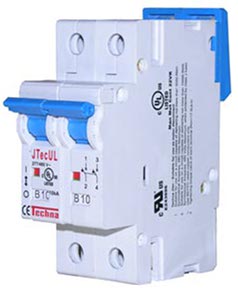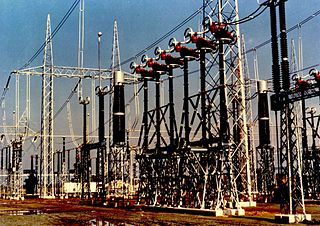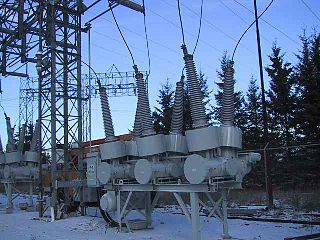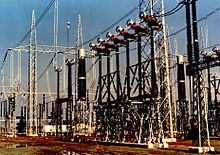
A circuit breaker is an electrical safety device designed to protect an electrical circuit from damage caused by current in excess of that which the equipment can safely carry (overcurrent). Its basic function is to interrupt current flow to protect equipment and to prevent fire. Unlike a fuse, which operates once and then must be replaced, a circuit breaker can be reset to resume normal operation.

A substation is a part of an electrical generation, transmission, and distribution system. Substations transform voltage from high to low, or the reverse, or perform any of several other important functions. Between the generating station and consumer, electric power may flow through several substations at different voltage levels. A substation may include transformers to change voltage levels between high transmission voltages and lower distribution voltages, or at the interconnection of two different transmission voltages. They are a common component of the infrastructure. There are 55,000 substations in the United States.

In electronics and electrical engineering, a fuse is an electrical safety device that operates to provide overcurrent protection of an electrical circuit. Its essential component is a metal wire or strip that melts when too much current flows through it, thereby stopping or interrupting the current. It is a sacrificial device; once a fuse has operated, it is an open circuit, and must be replaced or rewired, depending on its type.

In electric power distribution, automatic circuit reclosers (ACRs) are a class of switchgear designed for use on overhead electricity distribution networks to detect and interrupt transient faults. Also known as reclosers or autoreclosers, ACRs are essentially rated circuit breakers with integrated current and voltage sensors and a protection relay, optimized for use as a protection asset. Commercial ACRs are governed by the IEC 62271-111/IEEE Std C37.60 and IEC 62271-200 standards. The three major classes of operating maximum voltage are 15.5 kV, 27 kV and 38 kV.

In an electric power system, a switchgear is composed of electrical disconnect switches, fuses or circuit breakers used to control, protect and isolate electrical equipment. Switchgear is used both to de-energize equipment to allow work to be done and to clear faults downstream. This type of equipment is directly linked to the reliability of the electricity supply.

A crowbar circuit is an electrical circuit used for preventing an overvoltage or surge condition of a power supply unit from damaging the circuits attached to the power supply. It operates by putting a short circuit or low resistance path across the voltage output (Vo), like dropping a crowbar across the output terminals of the power supply. Crowbar circuits are frequently implemented using a thyristor, TRIAC, trisil or thyratron as the shorting device. Once triggered, they depend on the current-limiting circuitry of the power supply or, if that fails, the blowing of the line fuse or tripping the circuit breaker.

In electrical engineering, a disconnector, disconnect switch or isolator switch is a type of switching device with visible contacts, used to ensure that an electrical circuit is completely de-energized for service or maintenance. They are often found in electrical distribution and industrial applications, where machinery must have its source of driving power removed for adjustment or repair. Disconnectors can be operated manually or by a motor, and may be paired with an earthing switch to ground the portion that has been isolated from the system for ensuring the safety of equipment and the personnel working on it.
Power system protection is a branch of electrical power engineering that deals with the protection of electrical power systems from faults through the disconnection of faulted parts from the rest of the electrical network. The objective of a protection scheme is to keep the power system stable by isolating only the components that are under fault, whilst leaving as much of the network as possible in operation. The devices that are used to protect the power systems from faults are called protection devices.

Arcing horns are projecting conductors used to protect insulators or switch hardware on high voltage electric power transmission systems from damage during flashover. Overvoltages on transmission lines, due to atmospheric electricity, lightning strikes, or electrical faults, can cause arcs across insulators (flashovers) that can damage them. Alternately, atmospheric conditions or transients that occur during switching can cause an arc to form in the breaking path of a switch during its operation. Arcing horns provide a path for flashover to occur that bypasses the surface of the protected device. Horns are normally paired on either side of an insulator, one connected to the high voltage part and the other to ground, or at the breaking point of a switch contact. They are frequently to be seen on insulator strings on overhead lines, or protecting transformer bushings.
In Electrical Power Systems and Industrial Automation, ANSI Device Numbers can be used to identify equipment and devices in a system such as relays, circuit breakers, or instruments. The device numbers are enumerated in ANSI/IEEE Standard C37.2 "Standard for Electrical Power System Device Function Numbers, Acronyms, and Contact Designations".
Ferroresonance or nonlinear resonance is a type of resonance in electric circuits which occurs when a circuit containing a nonlinear inductance is fed from a source that has series capacitance, and the circuit is subjected to a disturbance such as opening of a switch. It can cause overvoltages and overcurrents in an electrical power system and can pose a risk to transmission and distribution equipment and to operational personnel.

A magnetic starter is an electromagnetically operated switch which provides a safe method for starting an electric motor with a large load. Magnetic starters also provide under-voltage and overload protection and an automatic cutoff in the event of a power failure.

An electric power system is a network of electrical components deployed to supply, transfer, and use electric power. An example of a power system is the electrical grid that provides power to homes and industries within an extended area. The electrical grid can be broadly divided into the generators that supply the power, the transmission system that carries the power from the generating centers to the load centers, and the distribution system that feeds the power to nearby homes and industries.

Sulfur hexafluoride circuit breakers protect electrical power stations and distribution systems by interrupting electric currents, when tripped by a protective relay. Instead of oil, air, or a vacuum, a sulfur hexafluoride circuit breaker uses sulfur hexafluoride (SF6) gas to cool and quench the arc on opening a circuit. Advantages over other media include lower operating noise and no emission of hot gases, and relatively low maintenance. Developed in the 1950s and onward, SF6 circuit breakers are widely used in electrical grids at transmission voltages up to 800 kV, as generator circuit breakers, and in distribution systems at voltages up to 35 kV.
In electrical engineering, IEC 60269 is a set of technical standards for low-voltage power fuses. The standard is in four volumes, which describe general requirements, fuses for industrial and commercial applications, fuses for residential applications, and fuses to protect semiconductor devices. The IEC standard unifies several national standards, thereby improving the interchangeability of fuses in international trade. All fuses of different technologies tested to meet IEC standards will have similar time-current characteristics, which simplifies design and maintenance.

In electrical engineering utilization categories are defined by IEC standards and indicate the type of electrical load and duty cycle of the loads to ease selection of contactors and relays.

A motor control center (MCC) is an assembly to control some or all electric motors in a central location. It consists of multiple enclosed sections having a common power bus and with each section containing a combination starter, which in turn consists of motor starter, fuses or circuit breaker, and power disconnect. A motor control center can also include push buttons, indicator lights, variable-frequency drives, programmable logic controllers, and metering equipment. It may be combined with the electrical service entrance for the building.
A high-resistance connection (HRC) is a hazard that results from loose or poor connections in traditional electrical accessories and switchgear which can cause heat to develop, capable of starting a fire.

In electrical engineering, a vacuum interrupter is a switch which uses electrical contacts in a vacuum. It is the core component of medium-voltage circuit-breakers, generator circuit-breakers, and high-voltage circuit-breakers. Separation of the electrical contacts results in a metal vapour arc, which is quickly extinguished. Vacuum interrupters are widely used in utility power transmission systems, power generation unit, and power-distribution systems for railways, arc furnace applications, and industrial plants.
In an electrical power distribution system, a ring main unit (RMU) is a factory assembled, metal enclosed set of switchgear used at the load connection points of a ring-type distribution network. It includes in one unit two switches that can connect the load to either or both main conductors, and a fusible switch or circuit breaker and switch that feed a distribution transformer. The metal enclosed unit connects to the transformer either through a bus throat of standardized dimensions, or else through cables and is usually installed outdoors. Ring main cables enter and leave the cabinet. This type of switchgear is used for medium-voltage power distribution, from 7200 volts to about 36000 volts.














